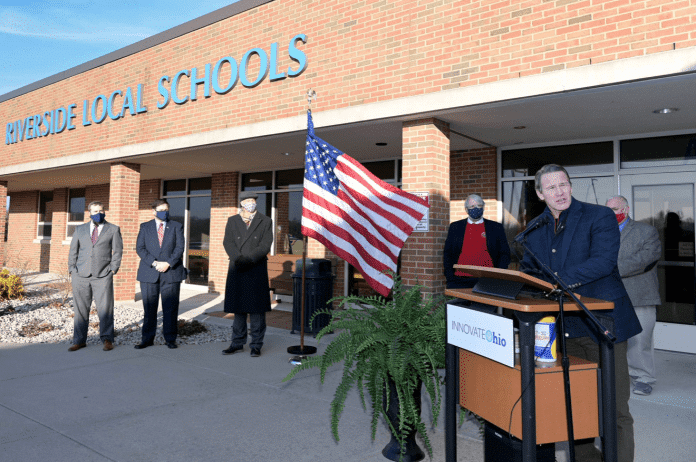
Pilot project expands broadband to southern Ohio communities | “The great news about this project is it’s not only serving the school and the students, but it’s serving the local community as well,” said Lt. Gov. Jon Husted.
Lt. Gov. Jon Husted, director of InnovateOhio, today visited Riverside Local School District in Logan County to announce the launch of several projects at the school that are funded through Ohio’s K-12 Broadband Connectivity Grant and that will help provide affordable high-speed internet access to a student population that is largely underserved by broadband.
Husted was joined by Paolo DeMaria, the state’s superintendent of public instruction; Scott Mann, superintendent of Riverside Schools; and other state and local partners to highlight the district’s use of federal CARES Act funding that was set aside by the state to provide hotspots and internet-enabled devices to Ohio students.
“The great news about this project is it’s not only serving the school and the students, but it’s serving the local community as well,” said Husted. “They are going to have access to high-speed internet in all of these small rural towns, places that never had access before, because we’ve created new partnerships with the private sector, the not-for-profit sector and the government sector.”
Through a pilot project implemented by InnovateOhio and BroadbandOhio, Riverside collaborated with OARnet and PCs for People to utilize a new fixed wireless technology on school property that can bring broadband access to approximately 600 households in three surrounding towns (Logansville, De Graff and Quincy). The approach uses the school’s infrastructure through OARnet to broadcast a wireless signal out to the surrounding communities through an antenna situated on the lights of the school’s football field.
“A fundamental step toward strengthening remote education is removing barriers to internet connectivity,” said DeMaria. “The Riverside Local School District is a wonderful example of the innovative and resourceful ways Ohio schools are meeting the needs of students.”
Households within this range will then be able to connect to high-speed internet inside their homes through a partnership with PCs for People, a national non-profit organization that wipes all data, refurbishes, and then distributes digital devices to low-income households.
Families that sign up will pay as low as $15 per month for service and receive speeds estimated at 50 Mbps download and 5 Mbps upload with no contract and no added equipment fees.
Subscribers will pay a low upfront fee for a router and then a monthly fee of $15. The school district is subsidizing the cost of some units to help low-income households. The speed of internet will be twice that of the federal minimum definition of high-speed internet, providing an important opportunity for students to do their schoolwork remotely and families to work from home.
The school also used the K-12 Broadband Connectivity funding (that was facilitated by the Ohio Department of Education and the Management Council) to provide hotspots on school buses that drive around the community, offering a place for students to do homework if internet is not available to them in their homes.
“The broadband connectivity grant has afforded the capability to fill gaps in internet service for rural areas,” Mann said. “Riverside Local Schools is very excited about this opportunity and the benefits to the community that it provides.”
This public-private partnership, spurred by InnovateOhio and BroadbandOhio, was made possible through the cooperation of various entities including the school district, PCs for People, OARnet, the Management Council (which coordinates Ohio’s ITCs) and WOCO Information Technology Center.
NEWS & FEATURES – Find news and features for Youngstown, Ohio, and the greater Mahoning Valley. Includes feature articles, news briefs, interviews, Letters to the Editor, columnists, and special topics (education, local history, seasonal guides, community development, and community changes).
Metro Monthly is a local news and events magazine based in Youngstown, Ohio. Stay connected with news, features and essential Valley events. We circulate throughout the Mahoning Valley (and beyond) with print, online and flipbook editions. We offer print and website advertising. Office: 330-259-0435.
© 2021 Metro Monthly. All rights reserved.






